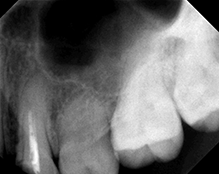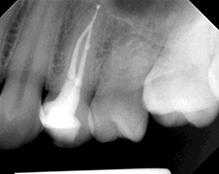Appointments
Call: 918-994-6000
Schedule your appointment for treatment in a relaxed environment with Dr. Johnson’s compassionate team.
Testimonials
Case of the Month
Everyone has heard horror stories about root canals, but when you ask the story teller about their experience, it’s rare they tell you about an experience they personally had. Root canals make for great stories and have been popularized by comedians and the media as painful. While this may have been true many decades ago, this is no longer the case.
Dr. Johnson will only treat you when you are 100% comfortable. This is normally achieved by injecting a small amount of anesthesic to gently numb a concentrated area of your mouth. You will feel pressure, but it will not be painful. You are in control! If you feel sharp pain during treatment, let us know and we will stop and take care of it. The anesthetics we use cause a feeling of numbness that usually subsides after 2-3 hours. Sometimes Dr. Johnson may decide to use a long-lasting anesthetic with pain medication, especially if you haven’t been able to sleep.
The cost varies depending on how complex the problem is and which tooth is affected. Molars are more difficult to treat, the fee is usually more. Most dental insurance policies provide some coverage for endodontic treatment.
Generally, endodontic treatment and restoration of the natural tooth are less expensive than the alternative of having the tooth extracted. An extracted tooth must be replaced with a bridge or implant to restore chewing function and prevent adjacent teeth from shifting. These procedures tend to cost more than endodontic treatment and appropriate restoration. With root canal treatment you save your natural teeth and money.
You should not chew or bite on the treated tooth until you have had it restored by your dentist. The unrestored tooth is susceptible to fracture, so you should see your dentist for a full restoration as soon as possible. Otherwise, you need only practice good oral hygiene, including brushing, flossing, and regular checkups and cleanings.
Most endodontically treated teeth last as long as other natural teeth. In a few cases, a tooth that has undergone endodontic treatment does not heal or the pain continues. Occasionally, the tooth may become painful or diseased months or even years after successful treatment. Often when this occurs, redoing the endodontic procedure can save the tooth.

To ensure longevity of the root canal treated tooth, Dr. Johnson recommends you return to your referring dentist as soon as possible. Your dentist will most likely place a crown on your tooth that sleeves and protects the tooth from fracture. Some patients choose porcelain (white) crowns over more tradional gold crowns. Ask your dentist for their recommendation and come to an agreement on the best option for your particular case.
Most teeth can be treated. Occasionally, a tooth can’t be saved because the root canals are not accessible, the root is severely fractured, the tooth doesn’t have adequate bone support, or the tooth cannot be restored. However, advances in endodontics are making it possible to save teeth that even a few years ago would have been lost. When endodontic treatment is not effective, endodontic surgery may be able to save the tooth.
All general dentists have received training in endodontic treatment and can perform most endodontic procedures, depending on their comfort level. Often they refer people needing complicated root canal treatment to endodontists, who have had specialized training and limit their practices to endodontic diagnosis and treatment. Endodontists perform routine as well as difficult and more complex procedures and are also experienced in helping to diagnose the cause of oral and facial pain that can be difficult to determine.

The practic of endodontics has changed significantly over the last 25 years. Many technological advances have made treatment more efficient and effective. Keeping up with the changes can be a challenge and very costly. Endodontists are obligated to provide treatment at the highest standard of care set by our specialty governing body. Standard in all endodontic offices are the use of surgical operating microscopes. You will see Dr. Johnson’s microscopes are connected to TV monitors enabling you to see what treatment is being performed on your tooth live. Microscopes allow complex treatment to be standard when paired with a skilled clinician. Dr. Johnson received microscope training as an integral part of her specialty education.
Sometimes, your body doesn’t respond to treatment, despite our best efforts. This can be due to persistent bacteria that can be difficult to remove and your immune system was not able to eliminate them. Additionally, new trauma, deep decay, or a loose, cracked or broken filling can cause new infection in your tooth. In some cases, the endodontist may discover additional very narrow or curved canals that could not be treated during the initial procedure. Doing the root canal again is termed retreatment.

Whenever possible, it is best to save your natural tooth. Retreated teeth can function well for years, even a lifetime. Advances in technology are constant and updated techniques may be used to save a tooth, which may not have been available when you had your first procedure. Dr. Johnson and Green Country Endodontics practice with the latest advances and have invested significantly in future-proofing the dental office to benefit you directly. The use of the dental operating microscope and cone-beam CT imaging are now seen as essential in any advanced endodontic practice.
If non-surgical retreatment is not an option, then endodontic surgery may be considered. This involves making an incision to allow access to the end of the root(s). Endodontic surgery may also be recommended in conjunction with retreatment or as an alternative.
The only other alternative to retreatment or failing endodontics ultimately is extraction of the tooth. It will then need to be replaced with an implant, bridge or removable partial denture to restore chewing function and aesthetics and importantly, to prevent adjacent teeth from shifting. Because these options require surgery or dental procedures on adjacent healthy teeth, they can be more costly and time consuming than retreatment and restoration of the natural tooth. You should discuss these options with Dr. Johnson so you make an informed and educated decision.


